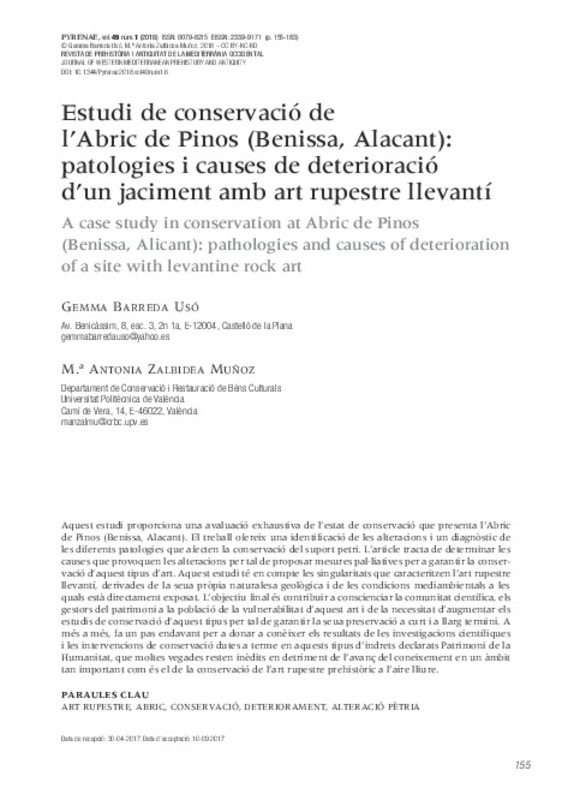JavaScript is disabled for your browser. Some features of this site may not work without it.
Buscar en RiuNet
Listar
Mi cuenta
Estadísticas
Ayuda RiuNet
Admin. UPV
Estudi de conservació de l Abric de Pinos (Benissa, Alacant): patologies i causes de deterioració d un jaciment amb art rupestre llevantí
Mostrar el registro completo del ítem
Barreda-Uso, G.; Zalbidea Muñoz, MA. (2018). Estudi de conservació de l Abric de Pinos (Benissa, Alacant): patologies i causes de deterioració d un jaciment amb art rupestre llevantí. PYRENAE. 49(1). doi:10.1344/Pyrenae2018.vol49num1.6
Por favor, use este identificador para citar o enlazar este ítem: http://hdl.handle.net/10251/107432
Ficheros en el ítem
Metadatos del ítem
| Título: | Estudi de conservació de l Abric de Pinos (Benissa, Alacant): patologies i causes de deterioració d un jaciment amb art rupestre llevantí | |
| Otro titulo: |
|
|
| Autor: | Barreda-Uso, Gemma | |
| Entidad UPV: |
|
|
| Fecha difusión: |
|
|
| Resumen: |
[EN] This study provides an in-depth evaluation of the state of conservation of abric de Pinos (Benissa,
Alacant) rock art site. This paper offers an identification of the main alterations as well as a
diagnostic of the ...[+]
[Otro] Aquest estudi proporciona una avaluació exhaustiva de l¿estat de conservació que presenta l¿Abric
de Pinos (Benissa, Alacant). El treball ofereix una identificació de les alteracions i un diagnòstic de
les diferents ...[+]
|
|
| Palabras clave: |
|
|
| Derechos de uso: | Reserva de todos los derechos | |
| Fuente: |
|
|
| DOI: |
|
|
| Editorial: |
|
|
| Versión del editor: | http://doi.org/10.1344/Pyrenae2018.vol49num1.6 | |
| Tipo: |
|









